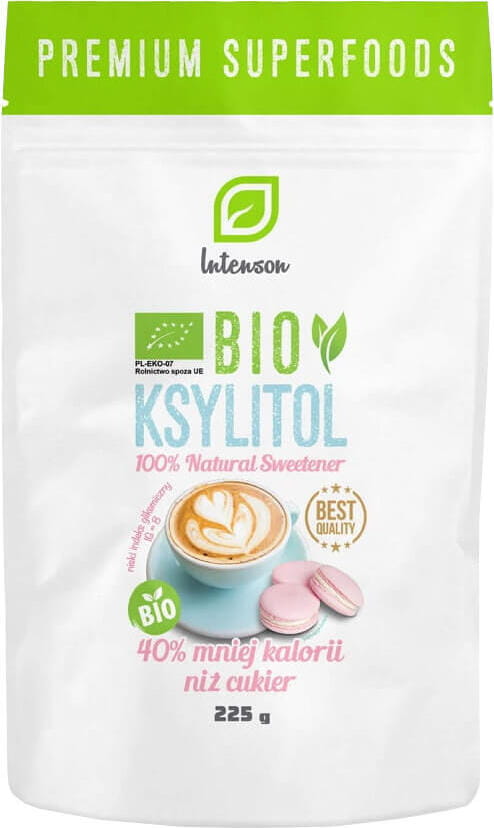ORGANIC xylitol sweetener 225g INTENSON table
- Regular price
- €5,84
- Regular price
-
- Sale price
- €5,84
- Unit price
- per
Couldn't load pickup availability
Description
xDESCRIPTION
- has a 40% lower calorific value than sugar
- the glycemic index of xylitol is only 8
- lowers the pH value in the oral cavity
- facilitates calcium absorption in the body
Xylitol, corn sugar - table sweetener. Xylitol is a sweetener of plant origin. It occurs naturally in raspberries, strawberries, plums, and even cauliflower. Finnish xylitol is xylitol extracted from birch. The term xylitol itself can refer to other fruits and vegetables. In these cases, it is most often made from corn. Depending on the product from which it is derived, we have different extraction methods. Birch xylitol is produced through fermentation carried out by bacteria and yeast. On the other hand, corn xylitol is produced through the hydrolysis of biomass. It has the appearance and sweetness of regular sugar but contains 40% fewer calories. In addition, it has a very low glycemic index (GI = 8), so it does not cause spikes in blood sugar and insulin levels. One gram contains only 2.4 calories. Its glycemic index is only 8, for comparison, traditional sucrose has an IG = 70 and glucose a high IG = 100. Therefore, it is a good substitute for sugar in people who should exclude products with a high glycemic index from their diet and do not want to give up sweetening coffee, tea or sweet snacks and cakes.
In food, xylitol is most commonly found in chewing gum and candy. It's increasingly being used as a sugar substitute in healthy versions of sweets and cakes. It's perfect for sweetening coffee, tea, smoothies, desserts, and ice cream. It's heat-stable, so we can easily replace sugar with xylitol in recipes.
The presence of xylitol in chewing gum is no coincidence. When consumed, xylitol is not fermented by bacteria, thus preventing the formation of acids that negatively affect tooth enamel. It also lowers the pH of the oral cavity and increases saliva production, which has a positive effect on the condition of our teeth. Xylitol also facilitates the absorption of calcium, making it a good option for people with calcium deficiencies. However, it does have one drawback: excessive consumption can lead to constipation, so it's worth controlling the amount consumed throughout the day.
INTEREST
Our body is able to produce xylitol itself; this happens during metabolism during digestion.
By replacing sugar in recipes with xylitol, we add the same amount of sugar as regular sugar because its sweetness is similar.
In food it appears under the symbol E967.
INGREDIENTS
100% organic xylitol.
Nutritional value of the product in 100 g:
Calorific value - 1 004 kJ / 240 kcal
Fat - 0 g
- including saturated fatty acids - 0 g
Carbohydrates - 99 g
- including sugar - 0 g
- Polyols - 99 g
Fiber - 0 g
Protein - 0 g
Salt - 0 g
APPLICATION
Use like white sugar. It should be introduced into the diet gradually (starting with 1/2 teaspoon per day). Consuming up to 10 teaspoons per day is recommended. Excessive consumption may have a laxative effect. Do not feed to animals!
STORAGE
Store in a cool, dry place.
similar products
- Regular price
- €5,84
- Regular price
-
- Sale price
- €5,84
- Unit price
- per
- Regular price
- €5,84
- Regular price
-
- Sale price
- €5,84
- Unit price
- per
- Regular price
- €5,84
- Regular price
-
- Sale price
- €5,84
- Unit price
- per
- Regular price
- €5,84
- Regular price
-
- Sale price
- €5,84
- Unit price
- per
- Regular price
- €5,84
- Regular price
-
- Sale price
- €5,84
- Unit price
- per
- Regular price
- €5,84
- Regular price
-
- Sale price
- €5,84
- Unit price
- per
- Regular price
- €5,84
- Regular price
-
- Sale price
- €5,84
- Unit price
- per
- Regular price
- €5,84
- Regular price
-
- Sale price
- €5,84
- Unit price
- per
- Regular price
- €5,84
- Regular price
-
- Sale price
- €5,84
- Unit price
- per
- Regular price
- €5,84
- Regular price
-
- Sale price
- €5,84
- Unit price
- per
Recently Viewed Products
- Regular price
- €5,84
- Regular price
-
- Sale price
- €5,84
- Unit price
- per
- Regular price
- €5,84
- Regular price
-
- Sale price
- €5,84
- Unit price
- per
- Regular price
- €5,84
- Regular price
-
- Sale price
- €5,84
- Unit price
- per
- Regular price
- €5,84
- Regular price
-
- Sale price
- €5,84
- Unit price
- per
- Regular price
- €5,84
- Regular price
-
- Sale price
- €5,84
- Unit price
- per
- Regular price
- €5,84
- Regular price
-
- Sale price
- €5,84
- Unit price
- per
- Regular price
- €5,84
- Regular price
-
- Sale price
- €5,84
- Unit price
- per
- Regular price
- €5,84
- Regular price
-
- Sale price
- €5,84
- Unit price
- per
- Regular price
- €5,84
- Regular price
-
- Sale price
- €5,84
- Unit price
- per
- Regular price
- €5,84
- Regular price
-
- Sale price
- €5,84
- Unit price
- per
- Choosing a selection results in a full page refresh.












